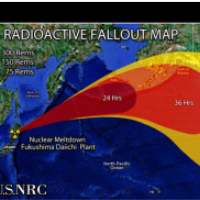Researchers Predict Radiation from Fukushima Nuclear Disaster to Hit U.S. West Coast by April
 Fukushima radioactivity map (graphic: Nuclear Regulatory Commission)
Fukushima radioactivity map (graphic: Nuclear Regulatory Commission)
Scientists from around the world have had three years to construct models for what effect radioactive water pouring into the ocean at the crippled Fukushima nuclear power plant in Japan might have when it reaches the West Coast of the United States.
They have now set the due date for April—although arrival may be early—as doomsayers warn of catastrophic consequences from the contamination. Scientists have more constrained, yet marked, differences of opinion, and federal and state governments are laying low.
The federal government is sufficiently unimpressed that it has not bothered to monitor the radiation’s approach. But the Center for Marine and Environmental Radioactivity (CMER) has used private funds to harness resources from around the world to track, measure and analyze this “unprecedented event” on its website.
Ken Buesseler, a chemical oceanographer, organized the crowdsourced science project at Woods Hole Oceanographic Institution in Massachusetts. He brought together volunteers to monitor ocean water at 16 sites in California and Washington State and two in Hawaii. The website lists 22 organizations that are helping, including the University of Hawaii, the University of California, Davis, Marine Pollution Studies Lab, Humboldt State University Marine Lab and Santa Barbara Channel Keeper.
The monitoring stations set up off the West Coast have not yet detected traces of radioactive isotopes from Fukushima, according to Buesseler. But he and others say it is just a matter of time for cesium-134 to show up in seawater off the U.S.
Scientists in Canada have reported only “minute traces of pollution from the beleaguered Japanese power plant” along their nation’s western shore, the BBC News says.
Although researchers have many models for predicting the impact of Fukushima radiation on the ocean, they have very little data to plug in them. While the levels of radioactivity are expected to be low when compared to acceptable drinking water concentrations, a larger concern is how that radiation may be entering the food chain through human consumption of contaminated fish.
Despite spearheading the project, Buesseler plays down the threat to people on the West Coast. “Unless we learn that the type or amount of material released is larger than reported or changes dramatically it will likely have significant long-term impacts only within a few miles or tens of miles from the plant,” he wrote in an FAQ.
But not everyone is buying it. Roger Gilbert, a physician and radiation oncologist involved in the water monitoring project, told the San Francisco Chronicle that there’s been “fear-mongering on the Internet about allegedly high levels of Fukushima radiation in California’s coastal waters.”
There have been earlier, unconfirmed reports on the Internet that harmful radiation has already washed up on California beaches. But those accounts have been refuted by scientists and health officials.
–Noel Brinkerhoff and Ken Broder
To Learn More:
Fukushima Radiation Could Reach Pacific Coast by April (by David Perlman, San Francisco Chronicle)
North American Scientists Track Incoming Fukushima Plume (by Jonathan Amos, BBC News)
Has Fukushima Radiation Reached North America? (by Lauren McCauley, Common Dreams)
Fukushima Radiation May Reach West Coast Within Weeks, But Don't Worry (Yet) (by Robin Wilkey, Huffington Post)
West Coast Radiation from Fukushima Disaster Poses No Risk, Experts Say (by Tony Barboza, Los Angeles Times)
FAQ: Radiation from Fukushima (Woods Hole Oceanographic Institute)
Study Suggests Fukushima Disaster Caused Thyroid Abnormalities in U.S. Babies (by Noel Brinkerhoff and Danny Biederman, AllGov California)
Japanese Radiation Arrives at U.S. Airports (by Noel Brinkerhoff, AllGov)
- Top Stories
- Controversies
- Where is the Money Going?
- California and the Nation
- Appointments and Resignations
- Unusual News
- Latest News
- California Forbids U.S. Immigration Agents from Pretending to be Police
- California Lawmakers Urged to Strip “Self-Dealing” Tax Board of Its Duties
- Big Oil’s Grip on California
- Santa Cruz Police See Homeland Security Betrayal in Use of Gang Roundup as Cover for Immigration Raid
- Oil Companies Face Deadline to Stop Polluting California Groundwater





